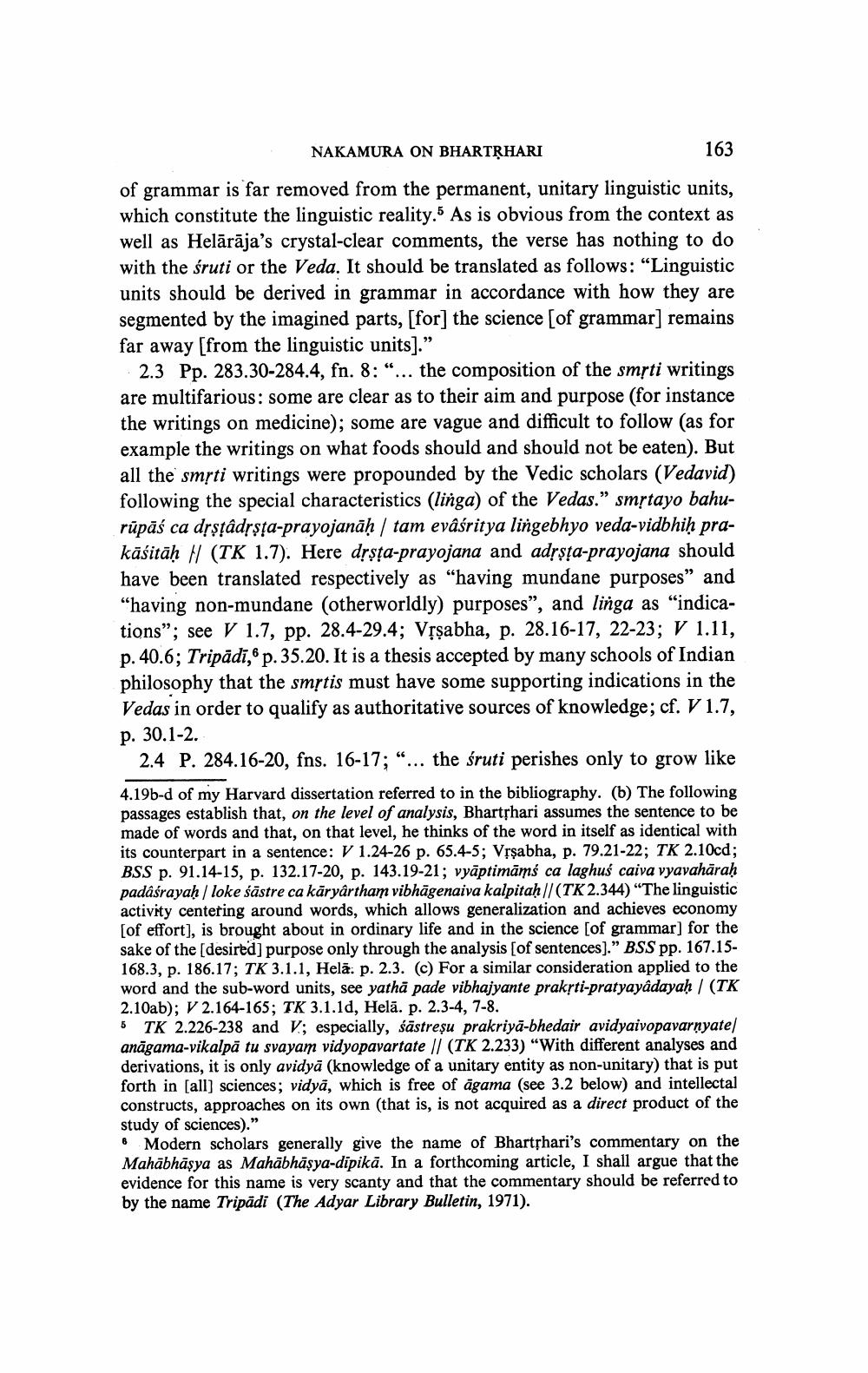Book Title: Nakamura On Bhartrhari Author(s): Ashok Aklujkar Publisher: Ashok Aklujkar View full book textPage 3
________________ NAKAMURA ON BHARTRHARI 163 of grammar is far removed from the permanent, unitary linguistic units, which constitute the linguistic reality.5 As is obvious from the context as well as Helārāja's crystal-clear comments, the verse has nothing to do with the śruti or the Veda. It should be translated as follows: "Linguistic units should be derived in grammar in accordance with how they are segmented by the imagined parts, (for) the science (of grammar] remains far away [from the linguistic units]." 2.3 Pp. 283.30-284.4, fn. 8: "... the composition of the smrti writings are multifarious: some are clear as to their aim and purpose (for instance the writings on medicine); some are vague and difficult to follow (as for example the writings on what foods should and should not be eaten). But all the smrti writings were propounded by the Vedic scholars (Vedavid) following the special characteristics (linga) of the Vedas.” smstayo bahurūpāś ca drșțâdsta-prayojanāḥ / tam evâśritya lingebhyo veda-vidbhiḥ prakāśitāḥ | (TK 1.7). Here drsta-prayojana and adrșța-prayojana should have been translated respectively as “having mundane purposes” and “having non-mundane (otherworldly) purposes”, and linga as “indications"; see V 1.7, pp. 28.4-29.4; Vịşabha, p. 28.16-17, 22-23; V 1.11, p. 40.6; Tripādī,6 p.35.20. It is a thesis accepted by many schools of Indian philosophy that the smrtis must have some supporting indications in the Vedas in order to qualify as authoritative sources of knowledge; cf. V 1.7, p. 30.1-2. 2.4 P. 284.16-20, fns. 16-17; "... the śruti perishes only to grow like 4.19b-d of my Harvard dissertation referred to in the bibliography. (b) The following passages establish that, on the level of analysis, Bhartphari assumes the sentence to be made of words and that, on that level, he thinks of the word in itself as identical with its counterpart in a sentence: V 1.24-26 p. 65.4-5; Vrşabha, p. 79.21-22; TK 2.10cd; BSS p. 91.14-15, p. 132.17-20, p. 143.19-21; vyāptimāmś ca laghuś caiva vyavahāraḥ padâśrayah / loke śāstre ca kāryârtham vibhāgenaiva kalpitaḥ//(TK 2.344) “The linguistic activity centering around words, which allows generalization and achieves economy (of effort), is brought about in ordinary life and in the science (of grammar) for the sake of the [desired] purpose only through the analysis (of sentences]." BSS pp. 167.15168.3, p. 186.17; TK 3.1.1, Helā. p. 2.3. (c) For a similar consideration applied to the word and the sub-word units, see yathā pade vibhajyante prakyti-pratyayâdayah / (TK 2.10ab); V 2.164-165; TK 3.1.1d, Helā. p. 2.3-4, 7-8. 5 TK 2.226-238 and V; especially, śāstresu prakriyā-bhedair avidyaivopavarnyatel anāgama-vikalpā tu svayam vidyopavartate // (TK 2.233) “With different analyses and derivations, it is only avidyā (knowledge of a unitary entity as non-unitary) that is put forth in (all) sciences; vidyā, which is free of agama (see 3.2 below) and intellectal constructs, approaches on its own (that is, is not acquired as a direct product of the study of sciences)." 6 Modern scholars generally give the name of Bhartshari's commentary on the Mahābhāsya as Mahābhāşya-dipikā. In a forthcoming article, I shall argue that the evidence for this name is very scanty and that the commentary should be referred to by the name Tripädi (The Adyar Library Bulletin, 1971).Page Navigation
1 2 3 4 5 6 7 8 9 10 11 12 13 14 15
